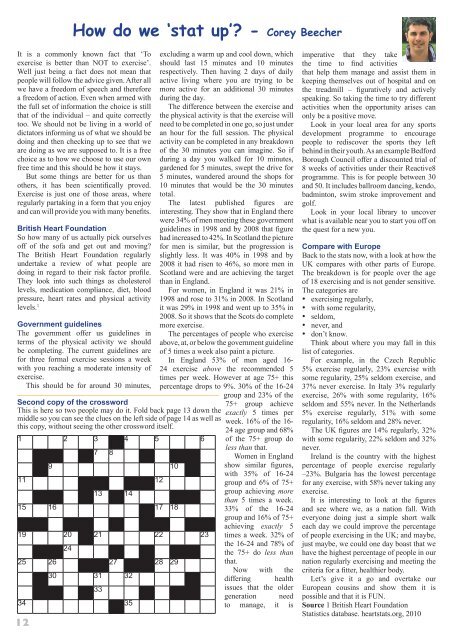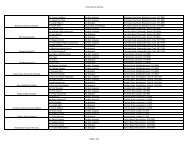BCPA Journal - Issue 184 - British Cardiac Patients Association
BCPA Journal - Issue 184 - British Cardiac Patients Association
BCPA Journal - Issue 184 - British Cardiac Patients Association
You also want an ePaper? Increase the reach of your titles
YUMPU automatically turns print PDFs into web optimized ePapers that Google loves.
12<br />
How do we ‘stat up’? - Corey Beecher<br />
It is a commonly known fact that ‘To<br />
exercise is better than NOT to exercise’.<br />
Well just being a fact does not mean that<br />
people will follow the advice given. After all<br />
we have a freedom of speech and therefore<br />
a freedom of action. Even when armed with<br />
the full set of information the choice is still<br />
that of the individual – and quite correctly<br />
too. We should not be living in a world of<br />
dictators informing us of what we should be<br />
doing and then checking up to see that we<br />
are doing as we are supposed to. It is a free<br />
choice as to how we choose to use our own<br />
free time and this should be how it stays.<br />
But some things are better for us than<br />
others, it has been scientifically proved.<br />
Exercise is just one of those areas, where<br />
regularly partaking in a form that you enjoy<br />
and can will provide you with many benefits.<br />
<strong>British</strong> Heart Foundation<br />
So how many of us actually pick ourselves<br />
off of the sofa and get out and moving?<br />
The <strong>British</strong> Heart Foundation regularly<br />
undertake a review of what people are<br />
doing in regard to their risk factor profile.<br />
They look into such things as cholesterol<br />
levels, medication compliance, diet, blood<br />
pressure, heart rates and physical activity<br />
levels. 1<br />
Government guidelines<br />
The government offer us guidelines in<br />
terms of the physical activity we should<br />
be completing. The current guidelines are<br />
for three formal exercise sessions a week<br />
with you reaching a moderate intensity of<br />
exercise.<br />
This should be for around 30 minutes,<br />
Second copy of the crossword<br />
This is here so two people may do it. Fold back page 13 down the<br />
middle so you can see the clues on the left side of page 14 as well as<br />
this copy, without seeing the other crossword itself.<br />
1 2 3 4 5 6<br />
7 8<br />
9 10<br />
11 12<br />
13 14<br />
15 16 17 18<br />
19 20 21 22 23<br />
24<br />
25 26 27 28 29<br />
30 31 32<br />
33<br />
34 35<br />
excluding a warm up and cool down, which<br />
should last 15 minutes and 10 minutes<br />
respectively. Then having 2 days of daily<br />
active living where you are trying to be<br />
more active for an additional 30 minutes<br />
during the day.<br />
The difference between the exercise and<br />
the physical activity is that the exercise will<br />
need to be completed in one go, so just under<br />
an hour for the full session. The physical<br />
activity can be completed in any breakdown<br />
of the 30 minutes you can imagine. So if<br />
during a day you walked for 10 minutes,<br />
gardened for 5 minutes, swept the drive for<br />
5 minutes, wandered around the shops for<br />
10 minutes that would be the 30 minutes<br />
total.<br />
The latest published figures are<br />
interesting. They show that in England there<br />
were 34% of men meeting these government<br />
guidelines in 1998 and by 2008 that figure<br />
had increased to 42%. In Scotland the picture<br />
for men is similar, but the progression is<br />
slightly less. It was 40% in 1998 and by<br />
2008 it had risen to 46%, so more men in<br />
Scotland were and are achieving the target<br />
than in England.<br />
For women, in England it was 21% in<br />
1998 and rose to 31% in 2008. In Scotland<br />
it was 29% in 1998 and went up to 35% in<br />
2008. So it shows that the Scots do complete<br />
more exercise.<br />
The percentages of people who exercise<br />
above, at, or below the government guideline<br />
of 5 times a week also paint a picture.<br />
In England 53% of men aged 16-<br />
24 exercise above the recommended 5<br />
times per week. However at age 75+ this<br />
percentage drops to 9%. 30% of the 16-24<br />
group and 23% of the<br />
75+ group achieve<br />
exactly 5 times per<br />
week. 16% of the 16-<br />
24 age group and 68%<br />
of the 75+ group do<br />
less than that.<br />
Women in England<br />
show similar figures,<br />
with 35% of 16-24<br />
group and 6% of 75+<br />
group achieving more<br />
than 5 times a week.<br />
33% of the 16-24<br />
group and 16% of 75+<br />
achieving exactly 5<br />
times a week. 32% of<br />
the 16-24 and 78% of<br />
the 75+ do less than<br />
that.<br />
Now with the<br />
differing health<br />
issues that the older<br />
generation need<br />
to manage, it is<br />
imperative that they take<br />
the time to find activities<br />
that help them manage and assist them in<br />
keeping themselves out of hospital and on<br />
the treadmill – figuratively and actively<br />
speaking. So taking the time to try different<br />
activities when the opportunity arises can<br />
only be a positive move.<br />
Look in your local area for any sports<br />
development programme to encourage<br />
people to rediscover the sports they left<br />
behind in their youth. As an example Bedford<br />
Borough Council offer a discounted trial of<br />
8 weeks of activities under their Reactive8<br />
programme. This is for people between 30<br />
and 50. It includes ballroom dancing, kendo,<br />
badminton, swim stroke improvement and<br />
golf.<br />
Look in your local library to uncover<br />
what is available near you to start you off on<br />
the quest for a new you.<br />
Compare with Europe<br />
Back to the stats now, with a look at how the<br />
UK compares with other parts of Europe.<br />
The breakdown is for people over the age<br />
of 18 exercising and is not gender sensitive.<br />
The categories are<br />
• exercising regularly,<br />
• with some regularity,<br />
• seldom,<br />
• never, and<br />
• don’t know.<br />
Think about where you may fall in this<br />
list of categories.<br />
For example, in the Czech Republic<br />
5% exercise regularly, 23% exercise with<br />
some regularity, 25% seldom exercise, and<br />
37% never exercise. In Italy 3% regularly<br />
exercise, 26% with some regularity, 16%<br />
seldom and 55% never. In the Netherlands<br />
5% exercise regularly, 51% with some<br />
regularity, 16% seldom and 28% never.<br />
The UK figures are 14% regularly, 32%<br />
with some regularity, 22% seldom and 32%<br />
never.<br />
Ireland is the country with the highest<br />
percentage of people exercise regularly<br />
–23%. Bulgaria has the lowest percentage<br />
for any exercise, with 58% never taking any<br />
exercise.<br />
It is interesting to look at the figures<br />
and see where we, as a nation fall. With<br />
everyone doing just a simple short walk<br />
each day we could improve the percentage<br />
of people exercising in the UK; and maybe,<br />
just maybe, we could one day boast that we<br />
have the highest percentage of people in our<br />
nation regularly exercising and meeting the<br />
criteria for a fitter, healthier body.<br />
Let’s give it a go and overtake our<br />
European cousins and show them it is<br />
possible and that it is FUN.<br />
Source 1 <strong>British</strong> Heart Foundation<br />
Statistics database. heartstats.org, 2010



